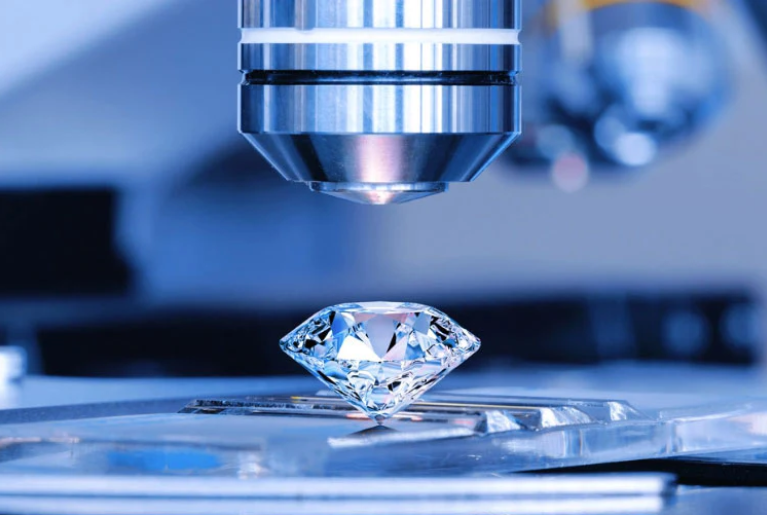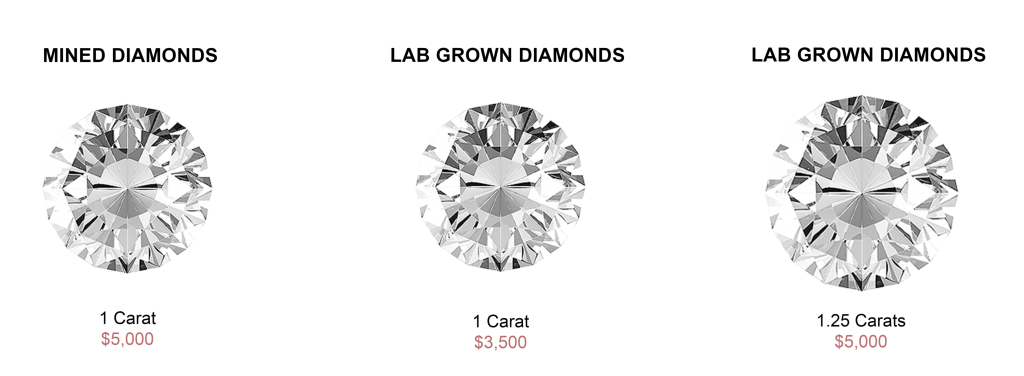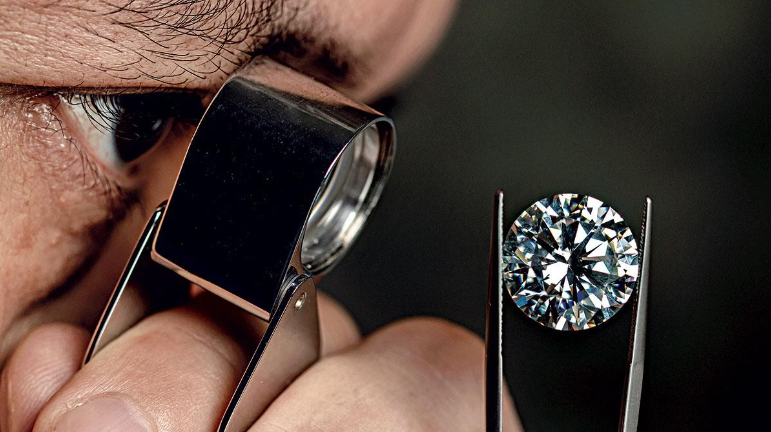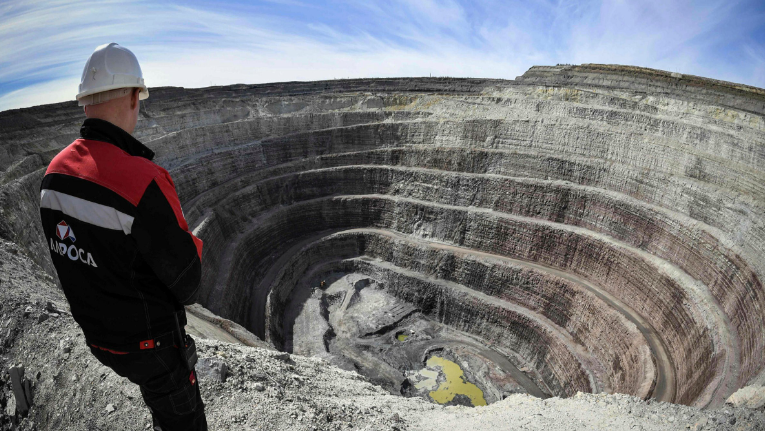Lab-grown diamonds have brought about a tremendous revolution in the dynamic world of the diamond business.
These artificial jewels, painstakingly created using cutting-edge technology, have drawn much attention for their exceptional beauty and moral ramifications. The primary reason lab-grown diamonds are so much less expensive than naturally mined diamonds is at the core of this burgeoning enthusiasm.
Investigating this fascinating question leads to an enthralling trip through the physics, economics, and ethical factors that support the affordability of lab-grown diamonds in contrast to those generated on Earth.
Understanding Lab-Grown Diamonds
Lab-grown diamonds are created in a laboratory using advanced chemical vapor deposition (CVD) technology.
This process involves exposing carbon atoms to high temperatures and pressure, which causes them to crystallize into diamond crystals. The resulting material is indistinguishable from natural diamonds under a microscope and has the same chemical, optical, and physical properties.
Another way to produce lab-grown diamonds is by using high-pressure, high-temperature (HPHT) technology. This process involves subjecting a diamond seed to extreme heat and pressure to trigger diamond growth. The result is a full-size diamond with similar characteristics as mined diamonds.
The quality and characteristics of lab-grown diamonds
While sharing the same chemical composition as their naturally formed counterparts, lab-grown diamonds boast unique attributes that set them apart within fine jewelry.
These exquisite gems are meticulously crafted under controlled conditions, yielding exceptional quality diamonds and consistent characteristics.
- The 4Cs: Regarding the renowned 4Cs—carat weight, cut, color, and clarity—lab-grown diamonds exhibit remarkable precision and consistency. They are available in various sizes and shapes, allowing consumers to select the perfect carat weight and cut to suit their preferences. The cutting process, guided by advanced technology, ensures exceptional symmetry and proportions, contributing to the diamond’s brilliance and sparkle.
- Color Variety: Lab-grown diamonds also provide an array of captivating colors, from classic white and near-colorless varieties to vibrant fancy colors. This palette of hues is achieved through the intentional introduction of trace elements during the growth process, resulting in a spectrum of colors that cater to various tastes and styles.
- Clarity Advantage: In terms of clarity, lab-grown diamonds often display fewer inclusions than their mined counterparts. The controlled environment in which they are grown allows for minimal internal imperfections, resulting in diamonds that frequently boast higher clarity grades.
- Ethical and Environmental Considerations: An additional advantage lies in the moral and environmental considerations associated with lab-grown diamonds. These gems are produced without the social and environmental challenges linked to traditional diamond mining. This newfound transparency and responsible sourcing further enhance the allure of lab-grown diamonds.
Cost Factors for Lab-Grown Diamonds
Exploring the pricing of lab-grown diamonds reveals a multifaceted interplay of factors contributing to their comparatively affordable nature.
Understanding the production costs of lab-grown diamonds offers insight into why these stunning gems often come at a more accessible price point than their mined counterparts.
1. Technological Advancements
Lab-grown diamond production hinges on cutting-edge technology, employing methods like Chemical Vapor Deposition (CVD) and High-Pressure High Temperature (HPHT) processes. Initial investments cover specialized facilities with advanced chambers, temperature controls, and monitoring systems.
However, these upfront costs yield efficient advantages. CVD and HPHT processes allow precise diamond cultivation, mimicking natural conditions while reducing long-term operational expenses.
Fine-tuned growth parameters and controlled carbon accumulation onto diamond seeds ensure consistent, high-quality diamonds, minimizing resource usage and waste.
This infusion of advanced technology showcases the scientific marvel of lab-grown diamonds and underscores their economic viability by optimizing resources and championing sustainability in diamond synthesis.

2. Time-Efficient Growth
In stark contrast to the natural diamond formation process that spans countless millennia beneath the Earth’s surface, lab-grown diamonds materialize within mere weeks, marking a seismic shift in the pace of creation.
This accelerated growth trajectory showcases scientific prowess and effectively reduces time-related costs, streamlining production and ushering in a new era of economic efficiency.
By implementing advanced techniques like CVD and HPHT processes, lab-grown diamonds capitalize on controlled laboratory environments to expedite their journey from diamond seed inception to polished gemstone. This, in turn, redefines industry norms and reaffirms the burgeoning prominence of artificial gems.
This condensed production timeline optimizes operational expenses and highlights the fusion of innovation and sustainability that lab-grown diamonds represent. In the process, offering a compelling glimpse into the future of responsible and efficient gemstone creation.
3. Reduced Resource Utilization
The distinction between traditional diamond mining and the creation of lab-grown diamonds is stark and far-reaching.
While traditional mining entails an exhaustive process involving extensive resource extraction, substantial labor, and intricate environmental considerations, the advent of lab-grown diamonds introduces a paradigm shift that prioritizes resource optimization and environmental responsibility.
In a departure from resource-intensive practices, lab-grown diamonds are a testament to innovation, harnessing controlled technological processes like Chemical Vapor Deposition (CVD) and High-Pressure High Temperature (HPHT) methods to cultivate diamonds in a controlled environment precisely.
This streamlined approach significantly reduces resource consumption, translating into decreased operational costs and a markedly reduced environmental footprint.
As the diamond industry navigates toward more sustainable horizons, lab-grown diamonds emerge not only as symbols of modern technological achievement but also as beacons of eco-consciousness, offering a promising glimpse into a future where an unwavering commitment to responsible production complements the allure of these exquisite gems.
4. Consistency in Supply
Lab-grown diamond production is defined by a meticulously controlled and precisely calibrated environment, which serves as the bedrock for ensuring a consistent and reliable output that meets the market’s demands.
This level of precision engenders a predictable supply chain management ecosystem that holds the key to stabilizing costs and engendering efficient inventory management practices.
Lab-grown diamonds exhibit a remarkable capacity to offer a dual advantage through the cultivation of diamonds within these controlled laboratory conditions.
They epitomize the cutting-edge fusion of scientific innovation and gemstone creation and present a strategic solution to the complex dynamics of cost fluctuations.
This capacity to harmonize technological advancements with financial pragmatism translates into a symbiotic relationship between reliability in supply and the seamless orchestration of inventory, further fortifying the position of lab-grown diamonds as a transformative force in the diamond industry’s evolution towards sustainability and economic sensibility.
5. Ethical Sourcing
The profound divergence in ethical implications between lab-grown diamonds and their mined counterparts extends far beyond their physical origins, resonating through complex socio-economic dimensions.
Lab-grown diamonds emerge as champions of responsible sourcing, skillfully bypassing the ethical quagmire entangled with traditional diamond mining – a quagmire characterized by concerns over labor rights, hazardous working conditions, and the potential financing of conflicts.
By diligently adhering to conscientious and transparent production practices, lab-grown diamonds forge a virtuous path in ethical provenance and preemptively avert the potential for substantial costs incurred through legal, reputational, and regulatory challenges arising from ethical controversies.
This ethical clarity forms an integral facet of lab-grown diamonds’ allure, resonating with the modern consumer’s conscientious sensibilities while safeguarding the industry against the socio-economic and legal ramifications endemic to mined diamond sourcing practices.
6. Market Demand and Perception
The burgeoning popularity of lab-grown diamonds is emblematic of a broader shift toward ethical and sustainable consumption practices, an evolution driven by an informed and conscientious consumer base.
As societal awareness expands regarding the detrimental social and environmental impacts associated with traditional diamond mining, lab-grown diamonds have emerged as a beacon of responsible luxury, resonating with the values of a generation attuned to the intricate interconnectedness of global systems.
Moreover, as demand for these ethically sound gems surges, economies of scale inevitably come into play, exerting potential downward pressure on production costs.
This intriguing symbiosis of heightened consumer interest and economies of scale enhances the affordability of lab-grown diamonds. It bolsters their position as a compelling choice in fine jewelry, underpinned by a profound commitment to ethical integrity and sustainability.
In this evolving landscape, lab-grown diamonds have the potential to redefine the luxury jewelry market and catalyze a transformative industry-wide shift toward a more responsible and conscientious future.
Comparison of production timescales for lab-grown versus natural diamonds
In the realm of precious gems, the formation of diamonds is a captivating narrative that spans geological epochs and modern scientific ingenuity.
The comparison of production timescales between lab-grown and natural diamonds unveils a remarkable duality, revealing how these exquisite gems emerge through a synergy of nature’s patient craftsmanship and humanity’s accelerated innovation.

1. Geological Transformation vs. Controlled Creation
Natural diamonds undergo an extraordinary journey that spans millions to billions of years. Carbon atoms deep within the Earth are subjected to immense heat and pressure, resulting in the slow crystallization that eventually forms diamonds.
This process encompasses geological events, tectonic shifts, and volcanic activities, culminating in the creation of these coveted gems.
In contrast, lab-grown diamonds use advanced techniques like Chemical Vapor Deposition (CVD) and High-Pressure High Temperature (HPHT) to replicate diamond formation in controlled laboratory environments.
By simulating the natural forces that lead to diamond growth, lab-grown diamonds emerge within a matter of weeks or months.
2. Millennia vs. Modern Mastery
The striking juxtaposition between the temporal dimensions of natural diamond formation and the accelerated genesis of lab-grown diamonds reverberates as a tribute to the equilibrium between nature’s unhurried craftsmanship and the swift strides of human ingenuity.
Similar to geological artifacts, natural diamonds encapsulate the unfolding story of our planet’s evolutionary journey across vast epochs. In stark contrast, lab-grown diamonds testify to our mastery over intricate processes, leveraging scientific comprehension to expedite growth.
With adept manipulation of crystal growth principles and technological precision, scientists engineer diamonds mirroring their natural counterparts’ physical, chemical, and optical attributes, yet achieve this feat in a fraction of the time.
This striking interplay between nature’s gradual orchestration and human’s accelerated artistry defines a narrative uniquely engraved upon the tapestry of diamond evolution.
3. Natural Variation vs. Predictable Consistency
The prolonged and intricate natural diamond formation process, encompassing millions to billions of years, imparts a kaleidoscope of individualistic attributes surrounding size, color, clarity, and inclusion patterns, imbuing each gem with a distinct and unparalleled uniqueness that harks to the Earth’s geological evolution.
This inherent variability, a hallmark of the natural world, endows natural diamonds with a captivating charm. Conversely, lab-grown diamonds, meticulously cultivated within controlled laboratory confines, exhibit exceptional uniformity and predictability across their attributes.
This adherence to a standardized growth environment results in a higher degree of consistency, catering to the contemporary palate of consumers who seek precisely tailored gems echoing a harmonious symmetry with their personal preferences, signifying the convergence of technological prowess and customized luxury.
4. Ethical Implications and Sustainability
The extended temporal trajectory characterizing the formation of natural diamonds evokes the majestic grandeur of geological epochs and casts a discerning spotlight on a spectrum of ethical considerations.
Labor practices, environmental ramifications, and the intricate web of conflict financing often interweave with the protracted journey of these precious gems, presenting a tableau of complexities that underscore the diamond industry’s responsibility to confront and address.
In this landscape, lab-grown diamonds emerge as an ethical beacon, their expedited and controlled creation process bypassing the multi-faceted dilemmas inherent in their naturally occurring counterparts.
By offering a transparent and traceable route from inception to fruition, lab-grown diamonds illuminate a path toward responsible luxury that resonates harmoniously with the growing chorus of conscientious consumers who champion sustainable practices, engendering a transformative pivot in fine jewelry.
5. Technological Advancement and Market Responsiveness
The inherent capability to efficiently generate lab-grown diamonds within a condensed timeframe emerges as a transformative force that empowers the diamond industry with unprecedented agility in adapting to the dynamic currents of consumer preferences and evolving market demands.
This remarkable flexibility is an outgrowth of the precisely controlled conditions meticulously orchestrated within laboratory settings, which expedite the growth process and furnish a platform for astutely calibrated responses to fluctuating requirements.
The controlled environment accelerates growth and fosters an environment conducive to real-time adjustments in production levels, a pivotal asset in maintaining an optimal equilibrium between supply and demand.
This adaptability, underpinned by the fusion of scientific precision and technological prowess, positions lab-grown diamonds as a versatile cornerstone of the jewelry market, capable of harmonizing rapid responses with the intricate beauty and allure intrinsic to these remarkable gems.
6. Shaping the Future of Jewelry
The insightful juxtaposition of production timescales provides a profound vantage point to discern the transformative trajectory that lab-grown diamonds have etched upon the age-old saga of gemstone formation.
In this enlightening contrast, the enduring chronicle of natural diamonds, enriched by geological epochs, stands juxtaposed with the modern-day narrative woven by lab-grown diamonds.
This narrative elegantly marries scientific exploration, cutting-edge innovation, and a steadfast commitment to ethical considerations.
Beyond their status as a mere scientific accomplishment, lab-grown diamonds unfurl as emblems of a more significant paradigm shift, symbolic of an era in which discerning consumers champion ideals of sustainability, environmental stewardship, and technological advancement.
Thus, these diamonds of a new era embody not merely a creative breakthrough in the art of gem cultivation but serve as tangible embodiments of evolving consumer ethos that prioritize a harmonious coalescence of luxury and responsibility, echoing the delicate cadence of progress.
The Market for Lab-Grown Diamonds

The market for lab-grown diamonds has experienced a remarkable evolution in recent years, driven by a convergence of shifting consumer values, technological advancements, and a growing desire for ethical and sustainable luxury options.
As consumers become increasingly conscious of their purchasing decisions’ environmental and social impacts, lab-grown diamonds have emerged as a compelling alternative to traditional mined diamonds.
This shift in consumer sentiment has fueled a surge in demand for lab-grown diamonds, reshaping the landscape of the diamond industry.
One of the primary drivers of the current market demand for lab-grown diamonds is their ethical provenance. Unlike mined diamonds, which often come with concerns about labor practices and potential ties to conflict financing, lab-grown diamonds offer a transparent and traceable supply chain.
This transparency resonates deeply with consumers who seek to align their purchases with their values, leading to a growing preference for lab-grown diamonds among ethically-minded buyers.
Technological advancements have also played a pivotal role in shaping the market demand for lab-grown diamonds.
The precision and control offered by techniques like Chemical Vapor Deposition (CVD) and High-Pressure High Temperature (HPHT) have allowed manufacturers to consistently produce high-quality diamonds with specific attributes, meeting the discerning preferences of consumers.
This technological prowess has elevated the credibility and desirability of lab-grown diamonds, further bolstering their market demand. Additionally, lab-grown diamonds have captured the imagination of a younger generation of consumers who prioritize innovation, uniqueness, and customization.
The ability to create diamonds with distinct colors, shapes, and sizes through controlled processes aligns with the individualistic preferences of modern buyers.
As lab-grown diamonds challenge traditional notions of luxury and exclusivity, they resonate with diverse consumers seeking personalized and avant-garde choices in their fine jewelry.
How market trends affect pricing
Market trends exert a multifaceted influence on the pricing dynamics of various commodities, and the realm of lab-grown diamonds is no exception. The intersection of consumer preferences, economic forces, technological advancements, and global supply and demand intricately shapes the pricing landscape of lab-grown diamonds. Several vital points shed light on the nuanced relationship between market trends and pricing:
1. Consumer Demand and Perception
The symbiotic relationship between consumer demand and pricing within the lab-grown diamond market is a testament to the power of shifting preferences.
As ethical and sustainable considerations gain prominence in the modern consumer psyche, lab-grown diamonds have become an alluring alternative to their mined counterparts.
The surge in demand for these ethically-sourced gems is not solely driven by their physical attributes but also by the values they embody. This heightened perception of lab-grown diamonds as symbols of responsible luxury bolster their appeal and, consequently, their pricing.
Consumers increasingly perceive lab-grown diamonds as exquisite gemstones and vehicles of positive change, creating a willingness to invest at a premium to align their purchases with their ethical convictions.
2. Supply and Demand Dynamics
The intricate dance between supply and demand dynamics navigates the labyrinth of pricing intricacies within the lab-grown diamond market.
A pronounced shift in consumer preference towards these sustainable gems can create an upsurge in demand that may outpace the industry’s capacity to produce them.
This supply scarcity can induce upward pressure on pricing as manufacturers and retailers endeavor to balance the delicate equilibrium between consumer appetite and gemstone availability.
Conversely, periods of oversupply may lead to pricing adjustments to maintain market equilibrium, leading to more competitive price points to incentivize consumer engagement in a saturated market.
3. Technological Advancements
Technological progress is a hallmark of the lab-grown diamond industry, continually reshaping the economic underpinnings of pricing.
Innovations in diamond cultivation methodologies, such as enhanced Chemical Vapor Deposition (CVD) techniques or more efficient High-Pressure High Temperature (HPHT) processes, introduce shifts in production costs that reverberate through pricing structures.
Adopting these advancements may increase prices, reflecting research and development investments. However, over time, economies of scale and streamlined production methods often mitigate these initial cost escalations, potentially leading to price reductions as efficiencies mature.
4. Brand Positioning and Competition
The symphony of market trends orchestrates a unique role for brand positioning within the pricing symposium. Established brands, adept at harnessing the pulse of consumer preferences, may strategically position themselves to resonate with evolving trends.
A successful alignment between brand ethos and prevailing market currents empowers these brands to command premium prices based on consumer loyalty, reputation, and perceived added value.
Conversely, increasing competition as newcomers enter the lab-grown diamond arena may foster pricing strategies focused on market penetration and capturing consumer attention in a competitive landscape.
5. Global Economic Factors
The pricing symphony of lab-grown diamonds is inevitably intertwined with the rhythm of global economic dynamics.
Fluctuations in currency exchange rates, inflationary pressures, and geopolitical events can cast a ripple effect that resonates across pricing structures.
Economic instability may prompt manufacturers and retailers to recalibrate prices to accommodate changing market conditions and consumer purchasing power, thereby contributing to the fluidity of pricing within the lab-grown diamond market.
6. Sustainability and Ethical Considerations
The ascendancy of sustainability and ethical considerations to the forefront of consumer consciousness has established an instrumental role in shaping lab-grown diamond pricing.
As consumers increasingly champion transparency, ethical sourcing, and reduced environmental impact, market trends amplify the demand for lab-grown diamonds.
The perceived intrinsic value of responsibly produced gems, coupled with their status as trailblazers in the realm of ethical luxury, can engender a willingness among consumers to pay a premium that reflects both the physical attributes of the diamond and the values it embodies.
7. Fashion and Design Trends
The marriage of lab-grown diamonds with prevailing fashion and design aesthetics is an intricate dance that resonates within pricing structures.
The inherent versatility of lab-grown diamonds, coupled with their ability to be customized to specific cuts, colors, and sizes, positions them as harmonious companions to the fluidity of fashion trends.
Pricing fluctuations may arise as specific cuts, colors, or settings surge in popularity, reflecting the interplay between consumer preference and design innovation that guides the evolving pricing of lab-grown diamonds.
Environmental and Ethical Considerations

Environmental and ethical considerations have shaped industries in an era of heightened awareness of our global impact.
The world of commerce is increasingly attuned to the imperative of sustainability and ethical responsibility, as consumers and businesses alike seek to harmonize their choices with the well-being of the planet and the principles of ethical conduct.
Within this context, the diamond industry stands at the crossroads of tradition and transformation, as environmental and ethical considerations play an instrumental role in reshaping how we perceive, procure, and appreciate these exquisite gems.
Ethical benefits of lab-grown diamonds
The ethical benefits of lab-grown diamonds are substantial and multifaceted, resonating deeply with the values of conscientious consumers and contributing to the transformation of the diamond industry’s ethical landscape:
1. Conflict-Free Origins
One of the lab-grown diamonds’ most compelling ethical advantages is their conflict-free origins. Unlike mined diamonds, which have been entangled in controversies and associated with conflict financing, lab-grown diamonds are inherently untainted by such concerns.
This ethical virtue resonates deeply with conscientious consumers who seek assurance that their cherished possessions have not contributed to human suffering or geopolitical instability.
By choosing lab-grown diamonds, individuals can align their jewelry choices with their commitment to peace, human rights, and global well-being.
2. Humanitarian Impact
The ethical narrative of lab-grown diamonds extends to the realm of humanitarian impact. Reports of exploitative labor practices, hazardous working conditions, and inadequate worker compensation have often shadowed traditional diamond mining.
In contrast, lab-grown diamonds are cultivated through advanced scientific processes in controlled environments, eliminating the risk of human rights violations.
By opting for lab-grown diamonds, consumers contribute to a more equitable and humane diamond industry, supporting a shift away from practices that compromise the dignity and safety of workers.
3. Environmental Responsibility
The environmental ramifications of diamond mining are a profound ethical concern. Mined diamond extraction can involve extensive habitat disruption, deforestation, water pollution, and significant carbon emissions.
In contrast, the cultivation of lab-grown diamonds generates a significantly lower environmental footprint. The controlled laboratory environment enables precise resource management, reduced energy consumption, and minimal ecological disruption.
This alignment with environmental responsibility positions lab-grown diamonds as a conscious choice that mitigates harm to ecosystems and helps safeguard the planet’s natural resources for future generations.
4. Transparency and Traceability
The ethical benefits of lab-grown diamonds are heightened by the unprecedented level of transparency and traceability they offer.
Consumers increasingly seek to make informed choices about the products they purchase, and lab-grown diamonds provide a transparent and verifiable journey from inception to market.
Through robust tracking and documentation, consumers can trace the origins of their lab-grown diamonds, ensuring they are ethically sourced and responsibly produced.
This transparency fosters a sense of trust and empowers consumers to exercise their ethical agency, shaping the industry through their purchasing decisions.
5. Social Empowerment
Ethical considerations surrounding lab-grown diamonds encompass social empowerment on multiple fronts. In regions where traditional diamond mining has historically perpetuated cycles of poverty and inequality, the advent of lab-grown diamonds introduces a transformative opportunity.
By establishing local labs and creating skilled jobs, the lab-grown diamond industry can contribute to socioeconomic development, fostering economic resilience and social progress within communities.
This empowerment extends beyond individual consumers, forging connections that ripple through societies and contribute to positive change.
6. Innovative Leadership
The ethical embrace of lab-grown diamonds extends beyond individual choices to catalyze innovative leadership within the jewelry industry.
As consumers gravitate towards ethical and sustainable options, the demand for lab-grown diamonds encourages the industry to pivot towards responsible practices.
This dynamic fosters a culture of innovation, inspiring jewelry brands and manufacturers to explore novel ways of sourcing, producing, and marketing their products. In doing so, lab-grown diamonds become ethical choices and catalysts for industry-wide transformation.
7. Long-Term Viability
A noteworthy ethical advantage of lab-grown diamonds lies in their long-term viability as a sustainable and responsible choice. As consumer preferences evolve and gravitate towards ethically sourced products, lab-grown diamonds emerge as a steadfast and enduring option.
This durability is underscored by the alignment of lab-grown diamonds with the values and sensibilities of future generations. By embracing these gems, consumers make a current ethical choice and contribute to a lasting legacy of conscious luxury that resonates across time.
8. Cultural and Symbolic Alignment
The ethical resonance of lab-grown diamonds extends into cultural and symbolic alignment. In an era where ethical conduct, environmental stewardship, and social responsibility are increasingly prized, lab-grown diamonds are potent symbols of these evolving cultural narratives.
Choosing lab-grown diamonds becomes an act of personal and cultural significance, reflecting a commitment to values that extend beyond aesthetics.
These gems become emblems of conscious consumption, encapsulating a broader dedication to positive global change and contributing to a more ethically enlightened world.
Environmental impact of lab-grown versus natural diamonds
The quest for beauty and luxury is increasingly entwined with the imperative to safeguard our planet’s fragile ecosystem.
The environmental effect of natural and lab-grown diamonds has become a focal point of concern, illuminating the crucial role that conscious consumer choices play in shaping the future of the jewelry industry.
1. Resource Consumption and Ecological Footprint
The environmental contrast between lab-grown and natural diamonds hinges on their resource consumption and ecological footprint.
Traditional diamond mining entails significant land disturbance, deforestation, and habitat destruction. In contrast, lab-grown diamonds are cultivated within controlled environments, minimizing land use and drastically reducing the ecological toll.
2. Energy Intensity and Carbon Emissions:
Natural diamond extraction is energy-intensive, involving machinery, transportation, and processing, contributing to substantial carbon emissions.
Though lab-grown diamonds require energy for their creation, they generally have a lower carbon footprint due to streamlined production processes and reduced reliance on heavy machinery.
This juxtaposition underscores the potential of lab-grown diamonds to mitigate the industry’s contribution to climate change.
3. Water Usage and Pollution
The environmental discourse further embraces water consumption and pollution as critical considerations. Diamond mining’s insatiable thirst for water exacerbates scarcity in affected regions while contaminating precious water sources.
Lab-grown diamonds chart a divergent path by substantially minimizing water requirements. The tightly controlled laboratory setting reduces water consumption and bolsters responsible water stewardship.
4. Ecosystem Impact and Biodiversity
The environmental saga unfolds against the backdrop of ecosystems and biodiversity. Natural diamond mining can disrupt delicate ecosystems and jeopardize biodiversity by altering landscapes and habitats.
Lab-grown diamonds, cultivated within controlled environments, negate direct impacts on natural settings.
This preservation of ecosystems allows flora and fauna to flourish uninterrupted, illustrating lab-grown diamonds’ potential as catalysts for the protection and sustenance of our planet’s diverse life forms.
5. Social and Cultural Implications
The environmental and ethical dimensions of diamonds intertwine with social and cultural realms. Natural diamond mining has, in certain instances, led to community displacement and cultural heritage erosion.
Through their diminished ecological burden, lab-grown diamonds facilitate a more harmonious coexistence between human activities and cultural preservation. This dimension reframes the narrative, casting lab-grown diamonds as guardians of cultural integrity and social well-being.
6. Reclamation and Land Rehabilitation
The after-effects of diamond mining necessitate extensive land reclamation to mitigate environmental degradation and restore ecosystems. Lab-grown diamonds diverge from this restorative obligation due to their minimal land use.
This redirection of resources and efforts positions lab-grown diamonds as vanguards of resource-efficient luxury, channeling energy towards progressive sustainability initiatives rather than post-extraction rehabilitation.
7. Leveraging Innovation for Sustainability
The environmental discourse around lab-grown diamonds underscores technological innovation’s potency as a sustainability harbinger.
The ongoing refinement of cultivation processes offers a pathway to further reducing energy consumption, emissions, and other environmental impacts.
This trajectory highlights the industry’s proactive approach to ecological challenges through innovation, echoing a resonant call for responsible resource management.
8. Consumer Empowerment and Ethical Alignment
The decision between lab-grown and natural diamonds crystallizes into a powerful statement of consumer values. Opting for lab-grown diamonds empowers individuals to participate in environmental preservation actively.
This decision becomes a testament to their commitment to an ecologically conscious and sustainable future, channeling their aspirations for beauty and luxury through a prism of ethical alignment and global well-being.
Conclusion
The cost-effectiveness of lab-grown diamonds emanates from a confluence of factors, including streamlined production processes, reduced resource consumption, and the ability to bypass ethical and environmental challenges associated with traditional diamond mining.
This financial advantage stems from efficient technological innovations, accelerated growth cycles, and controlled supply chains. Lab-grown diamonds stand poised to catalyze a transformative shift in the jewelry industry, resonating with modern consumers’ ethical and sustainability-conscious sensibilities.
As awareness deepens and demand surges for responsibly sourced luxury, lab-grown diamonds are poised to flourish, redefining the diamond market’s economic landscape and paving the way for a more conscious, innovative, and harmonious future for the realm of fine jewelry.



